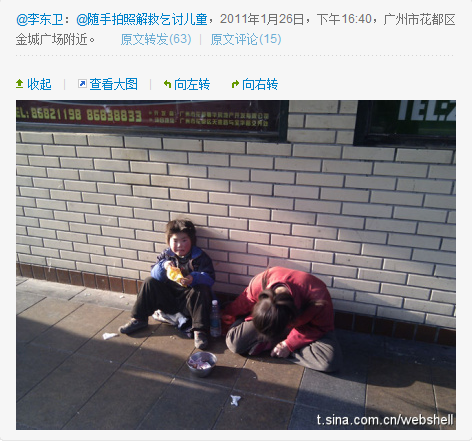 Recently there is a campaign on Sina Weibo (one of the most popular microblogging service in China) which draws lot of attention. The idea is simple: calling the public to take picture of child beggars they see on street, and publish the photo on Sina Weibo. With the account @随手拍照解救乞讨儿童 (Direct translation: Take a snapshot and save the child beggars) centralizing all that information, it then notifies local media and police – also using Sina Weibo.
Recently there is a campaign on Sina Weibo (one of the most popular microblogging service in China) which draws lot of attention. The idea is simple: calling the public to take picture of child beggars they see on street, and publish the photo on Sina Weibo. With the account @随手拍照解救乞讨儿童 (Direct translation: Take a snapshot and save the child beggars) centralizing all that information, it then notifies local media and police – also using Sina Weibo.
The public reaction so far is amazing. The official account for the campaign was registered on Jan 25, within 15 days, it has attracted over 70,000 followers. The issue is now on the trending topics list and ranked the third, with over half a million people involved, according to Sina’s statistics. Despite of the ongoing Chinese New Year, which would be assumed as a quiet period for any social campaigns, it has received over 1000 photo submissions from the public. Most of the submissions are simple, but meet the requirement: showing the face of the child beggar, and explaining where and when the photo was taken. A typical submission is like this:
Some thoughts on what makes the campaign so successful in such a short period of time:
1. It hits a real social problem
Children beggars are frequently seen on streets in Chinese cities. They are, in many cases, abducted, some deliberately handicapped, and forced to go on street begging, selling, or performing. The subject here, the kids, would easily raise the sympathy of a human being. The latests number I’ve seen is a 2008 statistics by Ministry of Civil Affairs, saying that there are around 1 to 1.5 million ‘wandering kids’ in China.
2. It is easy for netizens to participate
Even the name of the campaign emphasizes the easiness: take a snapshot. It takes you a second, and might save a child’s life. The popularity of mobiles with photo-taking function as well as the large crowd base of Sina Weibo lowers the entry-level of the participation as well.
Besides photo-taking, there are other netizens contributing their own skills as well. One Sina Weibo user @vinW developed an app which is a database of relevant information.
3. It is easy for media and police to follow up
To make this work, the inevitable assumption is that the media and police are really taking microblog platforms seriously – and they do. The campaign draws so much attention that many traditional media follow up – including CCTV (video in CN) and Xinhua (story in EN). Much more on Chinese local media. Also, I am surprised to find that so many local police stations are on Sina Weibo and are monitoring the messages and have follow-up actions. Interestingly, while some netizens submit the photo, they would complain that when they called the police, no one helped or showed willingness to deal with the issue. These kind of messages would easily raise public anger and pressured the police to take action.
4. It makes real social impact
This is what would reward the netizens the most. Up til now, according to a Guangzhou-based newspaper, there are three cases where parents doubt the children in the photo are their kids. Details are not disclosed before the police confirm their relationship and release the kids.
What makes the campaign more significant is that it is not only an effort online. Now at least a lawyer and a singer have confirmed that they will submit relevant proposals to Two Sessions which will be held next month (National People’s Congress & National Committee of the Chinese People’s Political Consultative Conference). It would be interesting to see what will happen then.
5. It is initiated by well-known professor and managed by full-time volunteers
I list this at the last because I am not sure how important the human factor is. The man behind the campaign is Prof. Yu Jianrong, who works at the Chinese Academy of Social Sciences. He himself has more than 342,000 followers on Sina Weibo, and he recruited two full-time volunteers to maintain the campaign account. He is recruiting more – obviously the public enthusiasm is beyond his expectation.
However there are concerns as well. To list a few here, and we’ll see how it goes.
1. Netizens’ safety issue
Some netizens, while uploading the photos, said that they were threatened not to take the photo. Citizens need to be more prepared to protect themselves as well as property (say, their mobile phone or camera) while participating.
2. Privacy (and safety) of the kids
It might sounds like a low-priority issue given that the kids are trapped already. But as the famous blogger Wang Xiaoshan raised on his Sina Weibo, those people who are behind the kids might kill them if they are scared of being caught. When all the photos are online, who knows who’s looking at them?
3. Where should the government and non-profits step in?
To solve the problem, after all it needs proper policy and long-term mechanism. Government, well. But the lack of non-profits’ voice in this campaign is out of my expectation. The only news is that One Foundation might fund the campaign. There should be more collaborations, esp. given Beijing is the hub of non-profits in China.
(I’ll get back to this case later, maybe after the Two Sessions. )


1 Comments.